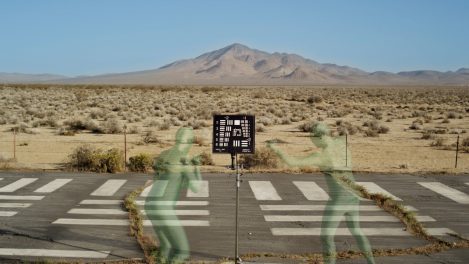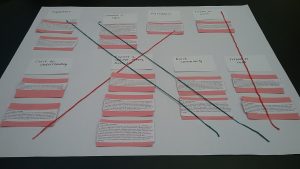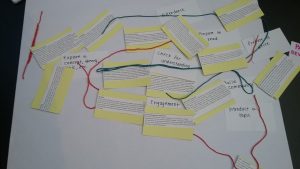In “Scaffolding, Hard and Soft – Infrastructures as Critical and Generative Structures” (2016) Shannon Mattern, Associate Professor of Media Studies at the New School, delivers a hopeful and inspiring message and provides a clear introduction to the importance of thinking about infrastructure in our work.
Shannon notes that new infrastructures – both hard and soft – are built on old ones. In the case of hard infrastructures, optic fibers are strung where cables and wires are traditionally laid, in sewage ducts and water and gas pipes, and alongside roads and railways. Many of these infrastructures are concentrated in cities or, in the case of satellites, directed towards large urban centers in more industrially and technologically developed parts of the world. Intellectual or soft infrastructures similarly follow old paths in their conceptual design. Despite their path dependency and heavy engineering new infrastructures bear the imprint of human agency, of the people who form part of these infrastructures as links, builders, and deliverers. Human agents are particularly evident when “in particular disenfranchised pockets of the world, when [the] scaffolding [that underlies more economically secure communities] is simply absent.” By turning our attention to the often precarious infrastructures in economically poorer parts of the world we see how splintered our “seemingly universal infrastructures” are.
The politics of hard and soft infrastructures are cleverly addressed in artist Hito Steyerl’s 2013 video How Not to Be Seen: A F***ing Didactic Educational .MOV File which Shannon Mattern recommends. In this radical work Steyerl declares that resolution determines visibility hence shows the world as a picture. Because pixel calibration determines visibility, she argues, to become invisible one has to become smaller or equal to one pixel, or be any number of things including someone living in a gated community, being in an airport or museum, being a female over 50, undocumented, poor, or “a disappeared person as an enemy of the state. Eliminated, liquidated and then disseminated.” Invisibility becomes a visible network in Steyerl’s film as disappeared people retreat strangely into 3D animations, then hold the vectors together and mesh the picture, then reemerge into a world of pictures as shadows of themselves. The video’s central recurrent image is a cracked and rutted resolution target in the California desert which Steyerl’s voice over says was decommissioned in 2000. “happy pixels hop off into low resolution, gif loop!” Multilayered and cryptic, Steyerl’s .MOV file is worth watching more than once.

Hito Steyerl, How Not to be Seen: A Fucking Didactic Educational .MOV File, (2013).
While artists must critique, it’s still not enough to represent, that is, to reveal and critically analyze, infrastructures, writes Mattern. Creative practitioners should design more just infrastructures, she adds. To do so and in doing so they should “approach infrastructure as a generative structure – a framework for generating systems and environments and objects, and cultivating individuals and communities, that embody the values we want to define our society.”
One of the examples of generative structures that Mattern provides is the use of existing infrastructure to bring about change in the labor conditions of workers in the fast fashion industry in countries like Bangladesh. This calls attention to materiality and affect in the communities involved in the production of clothes we see in store windows on, for example, 34th Street between 5th and 6th. Another example of infrastructure as a generative structure provided by Mattern are mesh networks (see for example The Red Hook Wifi Project [2013]), which are particularly exciting to think about when one thinks of what can happen when infrastructure is not controlled by the community in moments of danger. Two such moments come to mind: Egypt during the Arab Spring, when Vodafone cut off internet and cellphone networks at the height of massive uprisings in Cairo in 2011, causing protesters to lose vital communication with each other about where Egyptian military were firing bullets and consequently being shot down by these. Puerto Rico following Hurricane Maria is another example where mesh networks would have facilitated rescue and recovery.
In less extreme situations landscape urbanism advocates for looking beyond architecture at infrastructures in all their complexity to seek more equitable models. Other fields can follow landscape urbanism’s lead, and an important thing we can do as graduate students is look at the infrastructure that shapes and girds our fields “or what we might call the ‘cultural techniques’ for making knowledge and generating work within a field” (Mattern).
Mattern’s closing message is inspiring and directive:
Recognizing what’s missing in your field’s current infrastructural ecology might inspire you to contribute to the design of a discursive space or a landscape of practice that embodies a political economy more in line with those liberal values that our theories espouse. You, as critical-creative practitioners, have the opportunity to transform criticality into generativity – to imagine and then construct the hard and soft scaffoldings for tomorrow’s fields of practice.
Learning how to code, critically reading artifacts and imagining new ways of doing things are essential to making meaningful contributions in our field. Thinking of infrastructure on all its scales, from corporeal to global, will point to where generative structures most urgently need to be built.




